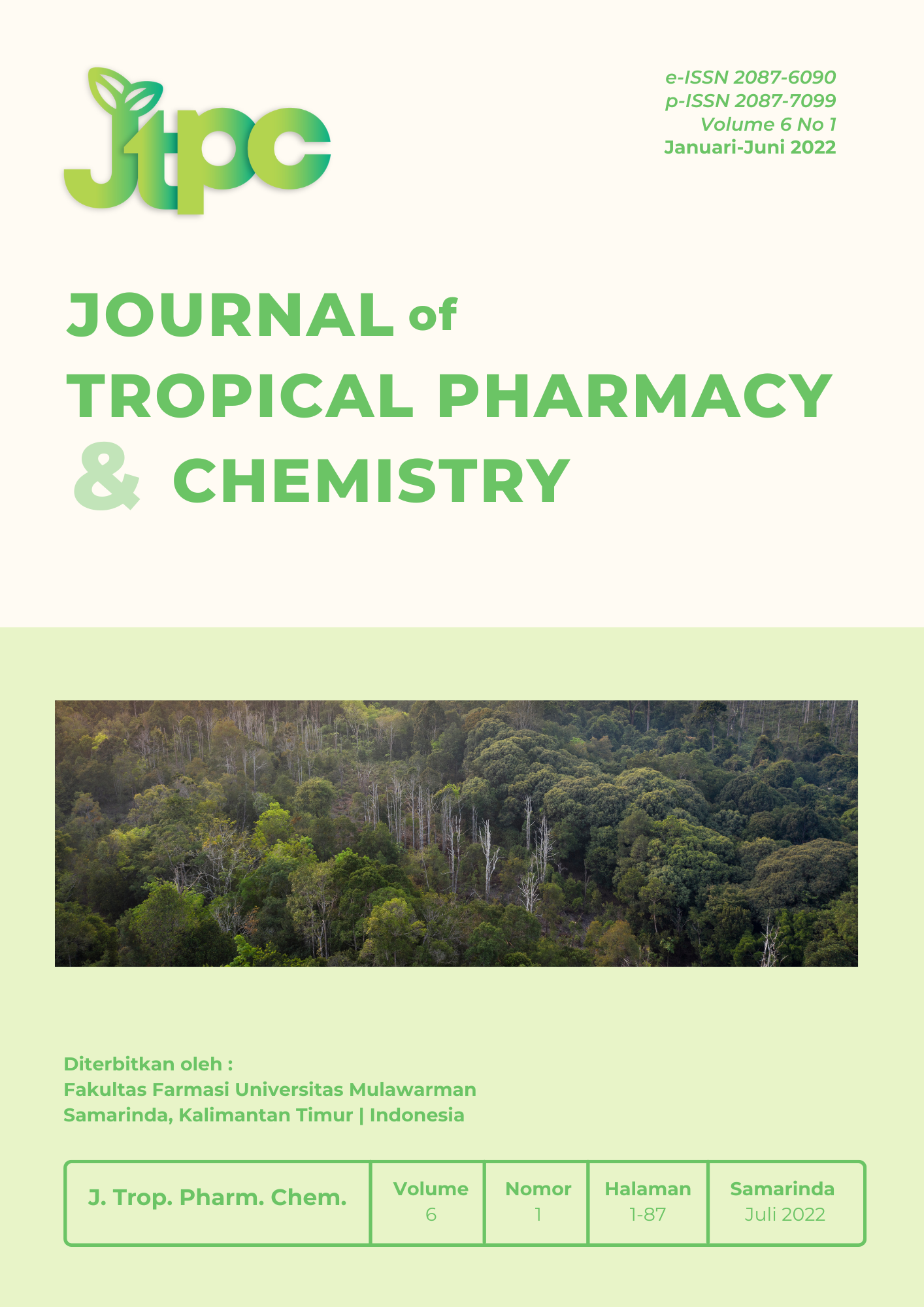Physicochemical Parameters and Purification of Pulp Effluent (Black Liquor)
DOI:
https://doi.org/10.30872/j.trop.pharm.chem.v6i1.225Keywords:
Pulp effluent (black liquor), Sand bed filters, Activated Carbon, Physicochemical parameters, APHAAbstract
Pulp and paper Industry poses a great significant problem in Environmental pollution and they consume high energy, water and resources. The present study was undertaken to purify pulp effluent (black liquor) using sand bed filters and adsorption method (Activated Carbon). The physicochemical parameters carried out were pH, colour, temperature, turbidity, total alkalinity (TA), total hardness (TH), chemical oxygen demand (COD), total suspended solids (TSS), total solids (TS) and total dissolved solids (TDS) using standard methods by American Public Health Association (APHA). The results obtained for black liquor and treated effluent were; colour (dark brown), pH (11.59 & 9.14), temperature (31 & 30 ), turbidity (1.78 &0.77 NTU), TA (10,000mg/L & 300mg/L), TH (325 mg/L & 220 mg/L), COD (2663 mg/L & 174.85 mg/L), TSS (0.09 mg/L & 0.00 mg/L), TS (0.9 mg/L & 0.17 mg/L), TDS (1354 mg/L) respectively. Highly significant differences were found between the effluent and treated water. The results indicated that pulp and paper Industrial effluents are highly polluted and can be toxic or harmful to human beings when released into water bodies without being treated.
Downloads
References
Nair, C.T.S. 2004. Trade of Forest Products in Africa: Opportunities and challenges: paper for a workshop on strengthening the regional action on implementation of IP/IF proposals for actions held during the African Forestry and Wildlife (AFWC), Accra, Ghana.
Market Pulp Association, 2008. Overview of the wood pulp industry. www.pppc.org/en/2_0/2_1.html
FAO, 2002a. Year book of forest products 2000. FAO statistics series No. 158, Rome.
FAO, 2002b. A treaty on plant genetic resources. Spotlight: Issues in World Agriculture, FAO Rome.
Muhammad, F., Abdul W., Amina, K. and Bell, J. N. B. 2013. Synthesis of Activated Carbon from tree sawdust and its usage for diminution of Color and COD of paper-mill effluents. Pakistan Journal of Botany, 45: 521-527.
U.S. Environmental Protection Agency (EPA), 1997. Office of Water, the Pulp and Paper Industry, the Pulping Process, and Pollutant Releases to the Environment.
Yuxing, W. and Jain, Y. 1999. Decolorisation of synthetic dyes and waste waters from textile, Water Research, 33 (16) 3512-3520.
Tantemsapya, N., Wirojanagud, W. and Sakolchai, S. 2004. Removal of color, COD and lignin of pulp and paper wastewater using wood ash. Environmental & Hazardous Management, 26.
Mauchauffee, M. P., Denieul (VEO), B., Simstich, J. and Rumpel. 2012. New technologies or innovative treatment lines for reliable water treatment for P&P and minimization of waste production” Aqua Fit4use.
Bahar, K.I., Zeynep, C. and Orhan, I. 2011. Pollution Prevention in the Pulp and Paper industries. Istanbul Technical university, Environmental Engineering Department, Istanbul, Turkey.
Yasmina, B., Krešimir, K., Emil, D. and Mirela, R. 2011. Wastewater from wood and pulp industry treated by combination of coagulation, adsorption on modified clinoptilolite tuff and membrane processes. Environmental Technology, 1-8.
Mohamed, N. R. 2013. Adsorption Technique for the Removal of Organic Pollutants from Water and Wastewater, Lintech.
Gonzalez, S.E., Cordero, T., Mirasol, J.R., Cotoruelo, L. and Rodriguez, J.J. 2004 Removal of water pollutants with activated carbons from H3PO4 activation of lignin from kraft black liquors. Water Research, 38: 3043- 3050.
D?browski, A., Podko?cielny, P., Hubicki, Z. and Barczak, M. 2005. Adsorption of phenolic compounds by activated carbon- a critical review, Chemosphere, 58:1049- 1070.
Moreno C.C., Rivera-Utrilla, J., López-Ramón, M.V. and Carrasco-Marín, F. 1995. Adsorption of some substituted phenols on activated carbons from a bituminous coal”, Carbon, 33 (6): 845- 851.
APHA, 2005. Standard methods for the examination of water”, 21st edition, American Public Health Association. Port City Press, Baltimore, Maryland, USA
Tripath, P., Joshi, G., Kumar, V., Nautiyal, R., Naithani, S., Panwar, S., Singh, S.P. 2013. A comparative study on physico-chemical properties of pulp and paper mill effluents. Int. Journal of Engineering Research and Applications, 3(6), 811-818.
Mahajan, S.P. 1985 Pollution control in Pulp and Paper Industries. In: Pollution Control in Process Industries. Tata McGraw-Hill Publishing Company Limited, New Delhi. Pp
Singh, R.S., Marwaha, S. S. and Khanna, P. K. 1996. Characteristics of pulp and paper mill effluents. Journal of Indian Pollution Control, 12(2), 163-172.
W.H.O, Guidelines for drinking water quality, Vol.1, Recommendations WHO, Geneva, 1984
ISI, Indian Standard specification for drinking water. 1983. IS10500, ISI, New Delhi. 235-254.
Saravana, E. J, Elayaperumal R, Kiruthika, M., Ramya, V. and Dharmalingam, P. 2014. “Effluents of Paper Mill: Physico-Chemical Properties of Water” International Journal of Chem tech research, PP 3544.
Makris, S. P. and Banerjee, S. 2002. Fate of resin acids in pulp mills secondary treatment systems, Water Research, 36, 2878-82.
Central Pollution Control Board (CPCB), 1975. Scheme for zoning and classification of Indian rivers, estuaries and coastal waters, ADSORBS/3 pp.78-79. Central Pollution Control Board, New Delhi.
Dutta, S. K. 1999. Study of the physic chemical properties of effluent of the paper mill that affected the paddy plants. Journal of Environmental Pollution, 5:13-9.
Downloads
Published
Issue
Section
License
Copyright (c) 2022 Oluwatosin Shokunbi, R.O Omenka (Author)

This work is licensed under a Creative Commons Attribution-NonCommercial 4.0 International License.




